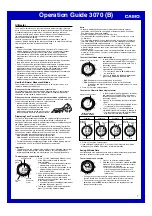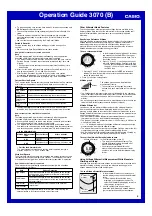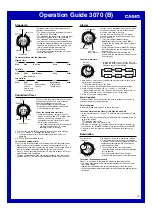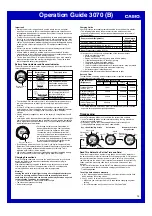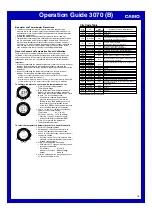
Operation Guide 3070 (B)
6
To determine the direction angle to an objective on a map and head
in that direction
1. Set the map so its northerly indication is
aligned with north as indicated by the watch,
and determine your current location.
•
See “To set a map and find your current
location” for information about how to
perform the above step.
2. As shown in the illustration to the left, change
your position so you (and the 12 o’clock position
of the watch) are pointed in the direction of
objective, while keeping the map aligned with
the readings being produced by the watch.
•
If you find it difficult to perform the above
step while keeping everything aligned, first
move into the correct position (12 o’clock
position of the watch pointed at the
objective) without worrying about the
orientation of the map. Next, perform step 1
again to set the map.
12 o’clock
position
N
N
Current
location
Objective
3. In the Timekeeping, Digital Compass,
Barometer/Thermometer, or Altimeter Mode,
press
C
to take a compass reading.
•
The reading will appear on the display after
about two seconds.
•
The indicator (indicating the direction stored
in Bearing Memory) and the direction of the
watch’s 12 o’clock position will disappear
from the display about 20 seconds after you
perform a compass reading by pressing
C
.
If this happens, press
C
again to take a
new reading and to display the indicator
(indicating the direction stored in Bearing
Memory).
12 o’clock
position
Bearing Memory
indicator
Bearing Memory
direction angle
Direction angle of
current reading
4. After setting the map, keep the map and watch pointed in the same
direction as you press
E
to record the currently displayed direction in
Bearing Memory.
•
See “Bearing Memory” for more information.
5. Now you can advance while monitoring the indicator (indicating the
direction stored in Bearing Memory) to ensure that it remains in the
12 o’clock position.
Note
•
When mountain climbing or hiking, conditions or geographic contours may
make it impossible for you to advance in a straight line. If this happens,
return to step 1 and save a new direction to the objective.
Barometer/Thermometer
This watch uses a pressure sensor to measure air pressure (barometric
pressure) and a temperature sensor to measure temperature.
•
You can calibrate the pressure sensor and the temperature sensor if you
suspect that readings are incorrect.
To take barometric pressure and temperature readings
Pressing
B
in the Timekeeping Mode or in any
of other sensor modes enters the Barometer/
Thermometer Mode and starts barometric
pressure and temperature measurements
automatically .
•
It can take up to four or five seconds for the
barometric pressure reading to appear after
you enter the Barometer/Thermometer Mode.
•
Barometric pressure is displayed in units of
1hPa (or 0.05 inHg).
Temperature
Barometric
pressure
Barometric
pressure graph
Pressure
differential
pointer
•
The displayed barometric pressure value changes to
xxxx
hPa (or inHg) if
a measured barometric pressure falls outside the range of 260 hPa to
1100 hPa (7.65 inHg to 32.45 inHg). The barometric pressure value will
reappear as soon as the measured barometric pressure is within the
allowable range.
•
Temperature is displayed in units of 0.1
°
C (or 0.2
°
F).
•
The displayed temperature value changes to
xxx
°
C (or
°
F) if a measured
temperature falls outside the range of –10.0
°
C to 60.0
°
C (14.0
°
F to
140.0
°
F). The temperature value will reappear as soon as the measured
temperature is within the allowable range.
•
In some areas, barometric pressure is expressed in millibars (mb) instead
of hectopascals (hPa). It really makes no difference, because 1hPa = 1mb.
Barometric Pressure Graph
Barometric pressure indicates changes in the atmosphere. By monitoring
these changes you can predict the weather with reasonable accuracy.
This watch takes barometric pressure measurements automatically every two
hours (at the top of each even-numbered hour), regardless of its current
mode. Measurement results are used to produce barometric pressure graph
and barometric pressure differential pointer readings.
The barometric pressure graph shows readings of previous measurements for
up to 24 hours. The horizontal axis of the graph represents time, with each dot
standing for two hours. The rightmost dot represents the most recent reading.
The vertical axis of the graph represents barometric pressure, with each dot
standing for the relative difference between its reading and that of the dots
next to it. Each dot represents 1hPa.
The following shows how to interpret the data that appears on the barometric
pressure graph.
A rising graph generally means improving weather.
A falling graph generally means deteriorating weather.
Note that if there are sudden changes in weather or
temperature, the graph line of past measurements may run
off the top or bottom of the display. The entire graph will
become visible once barometric conditions stabilize.
The following conditions cause the barometric pressure
measurement to be skipped, with the corresponding point on
the barometric pressure graph being left blank.
•
Barometric reading that is out of range (260 hPa/mb to 1,100 hPa/mb or
7.65 inHg to 32.45 inHg)
•
Sensor malfunction
Not visible on
the display.
Barometric Pressure Differential Pointer
This pointer indicates the relative difference between the most recent
barometric pressure reading indicated on the barometric pressure graph, and
the current barometric pressure value displayed in the Barometer/
Thermometer Mode.
•
Pressure differential is indicated in the range of
±
5 hPa, in 1-hPa units.
•
The barometric pressure differential pointer is not displayed when the
displayed current barometric value is outside of the allowable measurement
range (260 to 1,100 hPa).
•
Barometric pressure is calculated and displayed using hPa as the standard.
The barometric pressure differential also can be read in inHg units as
shown in the illustration.
Pressure differential
examples in the
illustration are indicated
in 3 hPa/0.1 inHg steps.
Current pressure less
than most recent
measured pressure
Current pressure greater
than most recent
measured pressure
Barometric pressure
differential
inHg values
hPa values
About Barometric and Temperature Measurements
•
Barometric pressure and temperature measurement operations are
performed as soon as you enter the Barometer/Thermometer Mode. After
that, barometric pressure and temperature measurements are taken every
five seconds.
•
You also can perform a barometric pressure and temperature measurement
at any time by pressing
B
in the Barometer/Thermometer Mode.
•
You can select either hectopascals (hPa) or inchesHg (inHg) as the display
unit for the measured barometric pressure, and Celsius (
°
C) or Fahrenheit
(
°
F) as the display unit for the measured temperature value. See “To select
the temperature, barometric pressure, and altitude units”.
•
See “Barometer and Thermometer Precautions” for important precautions.







